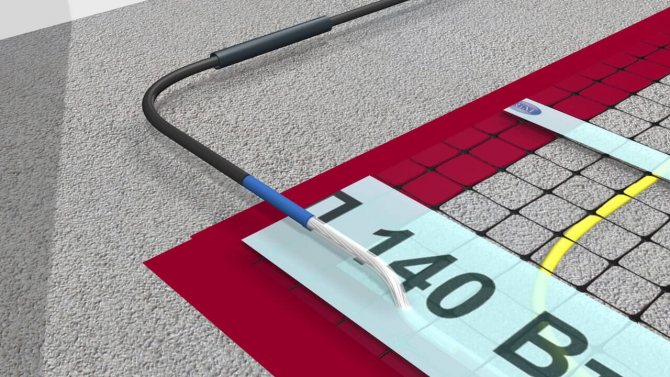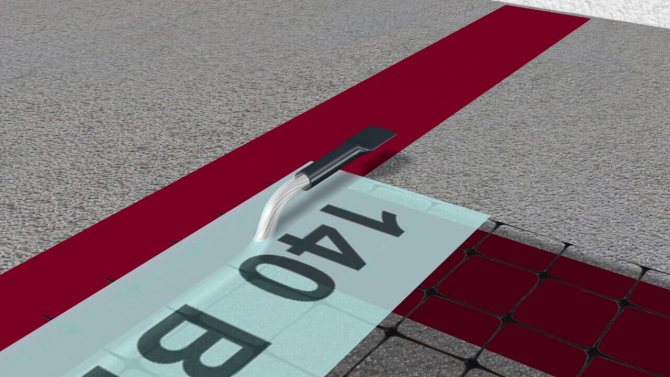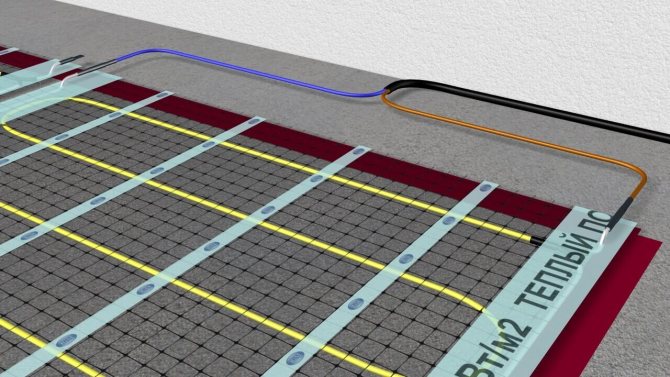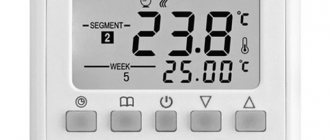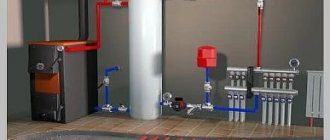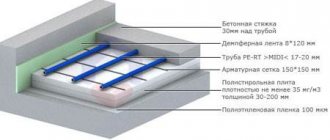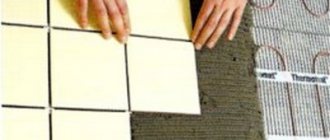Main varieties
Currently, we are talking about three methods of electric floor heating:
- Heating cables.
- Film warm floors.
- Heating mats.
Each of the varieties of electric heated floors has a different installation and heating principle. They are united only by the general principle of using the heat obtained by the passage of electricity through the conductor. The resulting heat energy is distributed by convection.
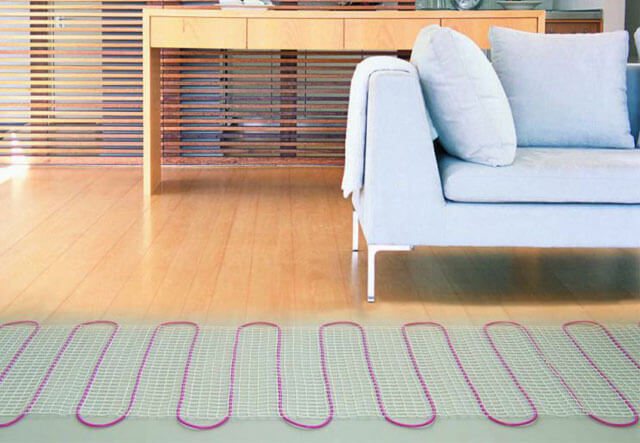
Another method was invented quite recently. It is built on the use of carbon, which emits energy in the infrared range when a current passes through it. This spectrum of waves has a much more beneficial effect on the body than heat waves, because similar radiation is inherent in our body. As a result, rooms heated by infrared rays are much more comfortable. Infrared floor heaters are available in the form of carbon film and carbon rod mats.
Any electric underfloor heating is equipped with a thermostat and a floor temperature sensor. These devices allow not only to set the operating mode, but also to monitor its implementation. Thanks to these devices, it is possible to reduce the consumption of electricity: they periodically turn on and off the floor heating. The beginning of the installation work is the correct placement of the thermostat and the execution of strobes for the wiring from the sensor. The subsequent actions are prescribed in the instructions from the manufacturer.
Underfloor heating with heating mats is easy
Heating mats are electric underfloor heating. The heating element is a heating or heating cable. The type of cable used in heating mats is resistive, the design of the cable is single-core or two-core.
The most important feature of heating mats, which forms both its advantages and disadvantages, is the factory readiness of the structure. The heating cable is already fixed to the reinforcement mesh with a cable zigzag pitch that cannot be changed.
As a result, heating mats are sold in ready-made kits designed for a certain area of the floor that needs to be heated.
Since it is quite difficult to cut the length of the mat on your own, when buying a ready-made set of heating mat, the area is rounded down. For example, for a room of 6.7 meters, take a mat for heating 6 meters of area.
The second feature of floor heating mats is the low power of the heating cable. Because of this, the thickness of the mat is insignificant and practically does not affect the structure of the floor.
However, the low power of the heating cable excludes laying the mat on the insulation layer. If you do this, then there is a high probability of overheating of the cable and its failure. As a result, the low power and the impossibility of using insulation, excludes the use of a heating mat as the main heating of the dwelling and the use over large areas.
The premises for using the heating cable are bathrooms, toilets, kitchens, balconies, corridors, hallways, small halls in the house. For example, I will give a table of ready-made designs of mats "Teplolux" ProfiMat.


As you can see, the maximum area that the mat can heat is 15 meters. Also pay attention to the spacing of the areas. It is 0.5 meters for small areas and 1-3 meters for medium ones. As I said, when buying, the area is rounded down.
If you add up all the listed features of heating cables, the recommended type of installation becomes clear.First of all, this is the installation of the heating mat under the tiles.
Heating mats for tiles are practically the ideal option for underfloor heating if you do not need or even want to increase the thickness of the floor. The heating mat is placed on a concrete base, without additional screeds, directly into the tile adhesive layer. Agree it's convenient.
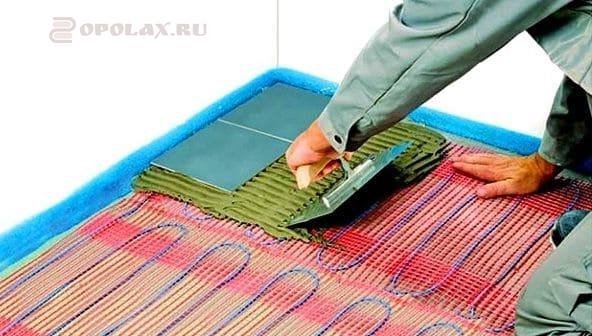

The second option, the use of a thermal mat is laying in a screed for subsequent finishing with carpet, laminate, linoleum, parquet board. In this installation option, the screed thickness should be minimal, that is, 3 cm without reinforcement. The mat is laid on a concrete base without the use of insulation.
Let's go back to laying the mat under the tiles and formulate the second minus of the heating mat. First minus we consider the impossibility of accurate calculation of the area of the room and the need to round the area down.
Second minus heating mat is a high probability of damage when laying it under the tiles in a layer of tile adhesive. The thickness of the cable in the mat is small, the cable is NOT armored and careless use of a notched trowel when laying tiles can damage the cable. This is not uncommon and should be kept in mind.
What is a thermostat
Strictly speaking, any underfloor heating system with a direct connection to the mains will also work. However, there is a real risk of overheating and rapid failure. In addition, the heating level will be completely uncontrolled, with the maximum consumption of electrical energy. In this case, the heating elements will undergo a constant load.
To avoid the above situations, three types of thermostats are used:
- Electromechanical
... By design, the devices resemble similar devices on irons. The heating level is adjusted by turning the knob left / right. Electromechanical devices are distinguished by simplicity of design and ease of use. The cost of these devices is quite low. - Electronic
... If the functions are similar to the previous version, they are implemented in a different way. The digital or liquid crystal screen displays the current parameters of the system, which can be adjusted with textile or touch buttons. To increase the parameter, press the "+" button, to decrease - the "-" button. Another type of performance of electronic regulators makes them much more expensive. - Programmable
(the so-called "programmers"). Along with the traditional regulation of the current floor temperature, in this case, it is possible to set certain indicators for a specific hour or day of the week. In some programmers for electric underfloor heating, the power adjustment of the heating elements depends on the outside temperature. For these purposes, a special sensor is being installed. Some models of programmable thermostats can be controlled from a computer.
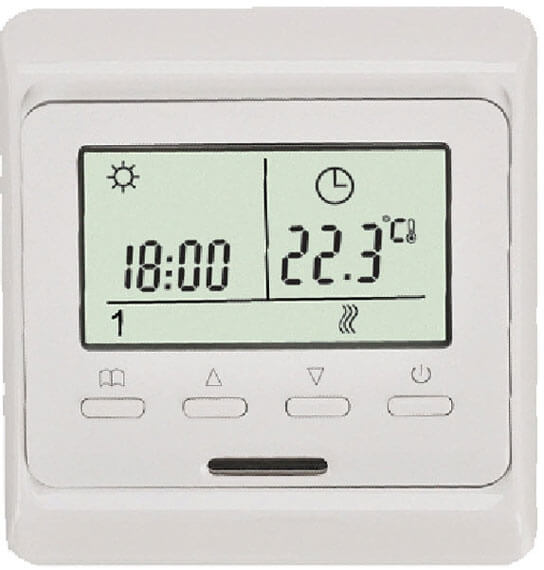

Installation of devices is usually carried out at the most convenient points in the room. Quite often, a thermostat is installed near a switch. If it is required to equip a room with high humidity with an electric underfloor heating, the thermostat is placed outside of it. The fact is that high humidity has a bad effect on the accuracy of the indicators. One device of this type is able to provide underfloor heating with a total power of 3 kW. If this indicator is exceeded, the circuit is divided into two parallel zones, each of which is equipped with its own sensor.
Classification of species
Heating mats, depending on the number of built-in cores, are divided into two types. Each type has its own technical characteristics and connection features.


Single core heating mat
Single core cable mats
The device has one conductor inside the cable. It is made from nichrome, brass or steel. There are also options for veins made of carbon compounds.
To connect a single-core wire to the regulator, its two ends are used. Therefore, the installation of the mats should be carried out so that the first and the last mat end up side by side. If you do not follow this execution technique, you will have to run a long cable from the beginning to the end of the circuit.
A single-core mat has a fairly low cost. But when the system heats up, electromagnetic radiation is emitted. The rate of outgoing waves does not exceed the permissible limits. However, it is not recommended to use this type of equipment in rooms where people spend a lot of time. Often, single-core mats in living quarters are installed in bathrooms or loggias.
Electric two-core mats
Equipment of this type consists of a heating core and a current-carrying wire. One side of the cable is closed with a sleeve, and the other is intended for connection to a regulating device.
This system design greatly simplifies the installation of underfloor heating equipment. At the same time, there is a significant suppression of the electromagnetic field, which makes it possible to use two-core mats for almost all types of premises.
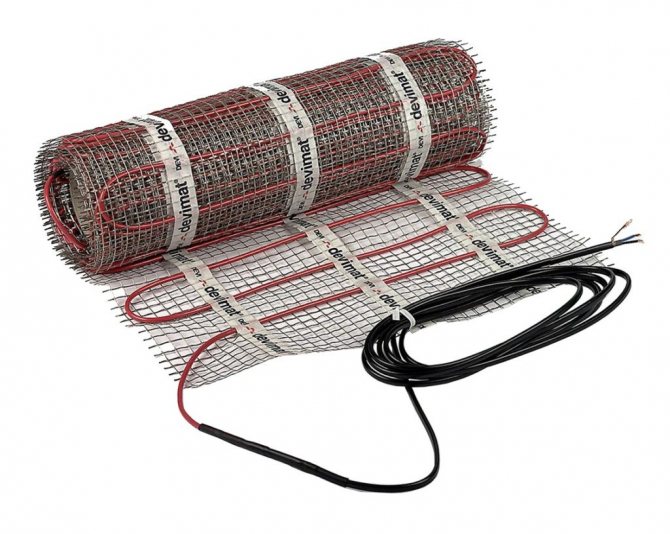

Two core heating mat
What is a heating cable
Resistive and self-regulating cables are used for arranging underfloor heating. Resistive products are characterized by a constant resistance and a stable level of heat transfer. This wiring can be single-core and two-core: the number of cores affects its switching scheme. The connection of a single-core cable is carried out by placing two ends of the coil on the thermostat. If a two-wire cable is used, then only one end is wound.
The self-regulating cable mechanism has the ability to adapt to the temperature of the surrounding space, with the correction of the amount of outgoing heat. Each of the sections can be regulated, which is not affected by the condition of the nearby cable. It often happens that an object is placed on the surface of the floor: this leads to an increase in the temperature under it. The self-regulating cable reacts to this by reducing the heat generated in this area by increasing its resistance (current strength and heating temperature decrease). At the same time, neighboring areas are operating normally. After the object is removed, the surface temperature is equalized.


The difference in characteristics explains the fact that the cables are laid in different ways. In the case of self-regulating products, the discount can be omitted for the arrangement of furniture items. Resistive models are mounted with great care: when developing a laying scheme, they preliminarily designate the zones for the location of furniture or objects suspended at a low height. This type of heating cable may only be installed in free areas. Therefore, the main disadvantage of resistive cable floors is their fear of overheating, which can cause them to burn out.
How to organize floor heating with heating cables
The general installation plan is as follows:
- Laying thermal insulation material on a flat, clean surface. For this, thermal insulation with a metallized coating is used.
- Installation of fasteners (metal mesh with small cells or mounting tape).
- Cabling. The developed plan of the arrangement of turns and lines is used as a diagram. It is also necessary to carry out the switching of the ends with a thermostat.
- Installation and connection of a temperature sensor to the thermostat.
- Laying concrete mortar. Layer thickness - at least 3 mm.
- Finishing coating arrangement. This can only be done on a completely dry screed after 28 days.
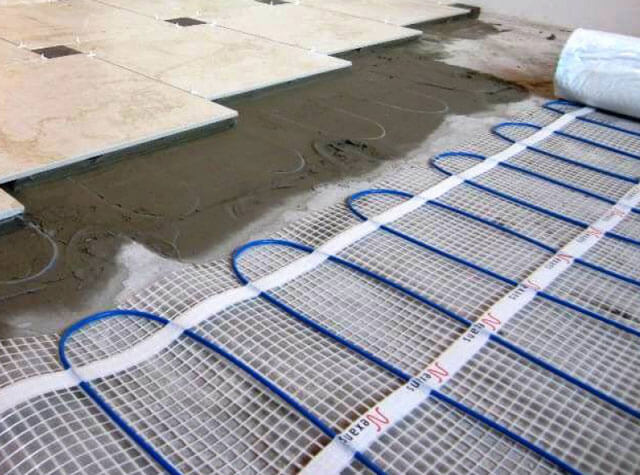

The heated floor can have a thickness of more than 50 mm, which is influenced by the height of the thermal insulation substrate. From above, the screed can be decorated with ceramic tiles, porcelain stoneware, laminate, linoleum, parquet. When pouring a screed or laying tiles, it is necessary to use special mixtures for underfloor heating. They are characterized by high elasticity, due to which the mortar is not covered with cracks due to thermal expansion. As for the cost, the least you have to pay for resistive cables for an electric floor heating. Self-regulating products are much more expensive.
Electric systems based on mats
There are two types of mats:
- Cable.
- Carbon fiber.
Products differ in the principle of heating, characteristics and cost. However, the way the mats are arranged is common: they look like a sheet folded into a roll. In this case, the difference between them also applies to the principle of installation and the materials of manufacture. Carbon mats are equipped with rod-type heating elements, which is why they are called rod-type heating elements.


A parallel connection is used to switch individual sections. The cable mats include a single-core heating cable with a snake. The basis here is a film with a reinforcing mesh. Installing a warm floor from mats is many times easier and faster than cable systems.
Cable mats
Cable mats are often used to equip warm floors under tiles. The total height of the cake of such an electrical structure is usually less than 30 mm. It is allowed to lay the mats on the old base: the main thing is that it is even. Before doing this, it is imperative to remove dirt and dust from the floor. An adhesive film base is used to fix the rolls. Next, the web is rolled out over the room, starting from the point of placement of the thermostat. The thermostat installation procedure completely coincides with a similar operation on cable heating systems. You will need to lay a corrugated hose for connecting cables and installing a floor temperature sensor.
The end line for rolling out the mat is the turning point: here the net must be cut off (the cable will not be damaged). After that, you can change the direction of the roll in the desired direction. When placing the next segment above or below the end point of the previous rolling, it is allowed to remove the cable of the required length from the mesh, followed by placing it in the form of a snake. The main thing is to completely roll out the entire roll (if not enough, take the next one). The second and third rolls are stacked in exactly the same way. Further, using a tester, the electrical resistance is checked for compliance with its passport values. The difference is allowed within 5-10%.
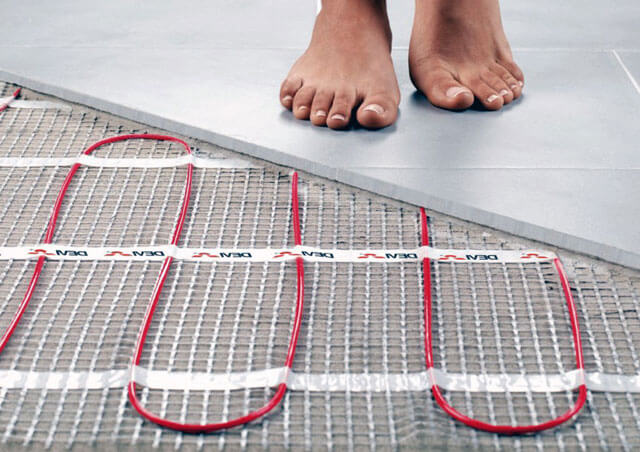

On the back there is a film that hides the adhesive surface. It is removed and the mat is glued to the floor surface. The next step is to place and connect the temperature sensors. A pipe or corrugated hose is used for laying. Taking into account the total thickness of the underfloor heating pie (no more than 30 mm), it is necessary to equip a seat in the rough base under the corrugated hose. Installing the sensor in an unprotected state is prohibited, otherwise it will quickly break. The option of placing it under the screed also has its flaws: when replacing it, you have to break the floor. Therefore, the most convenient option is to lay in a hose or pipe.
In the next step, tile adhesive is applied. The process is completely identical to laying concrete mortar, however, the thickness of the adhesive mixture is much thinner. After the glue dries, the decorative tiles are laid. This type of electric under-tile floor heating has the same weaknesses as the resistive cables that are part of it. Due to the danger of overheating, they should not be placed under furniture or carpets.
Flooring
If the underfloor heating was made under the tiles, then take a special tile adhesive for underfloor heating and put it directly on the mats (you can additionally put a reinforcing mesh - there will be more cables). You just need to remember that the thickness of the glue + tile must be more than 2cm. You can turn on the floor only after the glue has completely dried (each composition has its own time, indicated on the package).
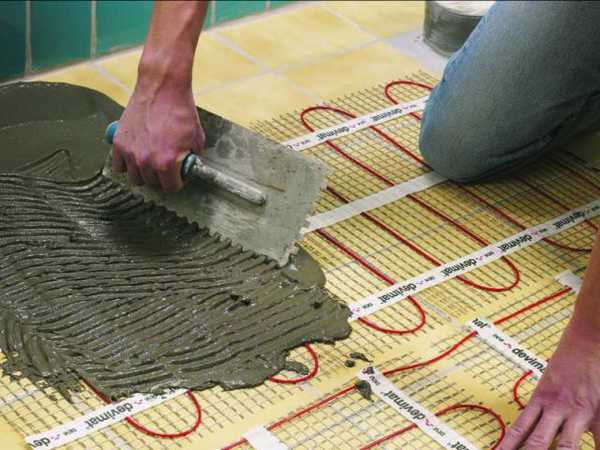

All floor coverings except tiles require a screed
A screed is required for all other coatings. Its thickness is 2-3cm. The composition is also for warm floors. After leveling the layer, leave to dry. Then lay laminate, carpet or parquet flooring. Read about the choice of finishing coat for a warm floor here.
Not the most difficult installation. What is upsetting is the need to wait for the tile and screed to "settle". In any case, it will be possible to turn on the warm electric floor only after the glue or mortar has dried. And you cannot use heating to speed up the process. This can damage the underfloor heating or lead to the formation of cracks, which will impair heat transfer.
Features of IR rod mats
For carbon mats, overheating is not terrible, because their design provides for the ability to independently adjust the temperature. The basis for laying this type of electric floor heating is a layer of metallized thermal insulation. This makes it possible to ensure that the infrared radiation diverges in all directions. The same part of the flow that goes towards the floor is reflected back into the room.
The installation of heat-insulating material with a reflective surface is carried out on a flat, clean base. To fix it, pieces of double-sided tape, staples or glue are used. For gluing the joints of thermal insulation, you will need metallized tape. Installation works completely repeat the same procedure with cable mats. The starting point is the location of the thermostat. Upon reaching the opposite wall, the connecting cable is cut between the two rods, followed by the unfolding of the web in the desired direction. Crossing of lanes is prohibited.


Fully unfolded mats should be taped to the floor or to each other. The thermal insulation material in the areas between the carbon rods is equipped with small cutouts: in these places the screed and the rough base will be fastened together. Electric cables are used to connect the individual strips of the heating sheet at the cuts. Upon completion of the commutation, the temperature sensors are installed. Finally, all nodes must be connected to the thermostat. For testing, the system is turned on for 15 minutes. If successful, start pouring the screed.
Other options:
- Arrangement of concrete screed with a thickness of more than 20 mm. In this case, it is allowed to use any kind of flooring.
- Installation of tiles directly on tile adhesive. The total height of such a design must exceed 20 mm.
Different rooms are suitable for using these methods: bathroom, kitchens, living quarters. In each of these cases, the work is carried out using special mixtures for underfloor heating.
Film type warm floors
In film systems of electric floor heating, the method of infrared radiation is used, therefore they also belong to infrared heated floors. The infrared film consists of strips of carbon fiber connected by a copper bus. Further, this frame is sealed in a polymer film (polypropylene or other material). When using electrical films, it is important to avoid overheating. For this reason, as with resistive heating cables, they must not be placed under furniture or low overhanging objects.
The installation method is very similar to that of other types of electric underfloor heating. On a flat rough surface, a layer of metallized thermal insulation is laid. The film is rolled on top of the heat-insulating material. To switch individual strips, you will need wires going to the thermostat. Having made the connection, the system must be tested at an operating temperature of up to +30 degrees. A sign of serviceability is the uniform heating of all strips with cold terminals.


On top of the rolled heating rolls, lay out a plastic wrap or non-woven windscreen. This will create protection from damage. If you originally planned to lay the laminate, this can be done now. During work, it is important to be very careful not to injure or move the electric film of the warm floor. Thermal insulation can be replaced with a conventional underlay.
If you plan to lay carpet or linoleum, you will first need to install hard plates: plywood, OSB, etc. During installation, you need to act very carefully, avoiding the slightest damage to the heating elements of the film. Such a substrate will become a reliable base for the floor covering. Also, sometimes a mobile warm floor is laid under the carpet, which does not require repair work. The use of film floors in combination with ceramic tiles is a bad idea, because of the threat of rapid deterioration of the web in the tile adhesive layer.
Raychem T2 QuickNet heating mats for underfloor heating
Raychem Moscow store invites everyone who would like to buy Raychem heating mats for cooperation. The manufacturing company has long established itself as one of the leading brands in the field of creating electrical heating systems. Products of this brand have long been recognized as the standard of quality and reliability. It is actively used in the organization of heating systems for private houses and apartments.
Features and characteristics
Heating mats "Raychem" will help to make the floor warm and the room as comfortable as possible. The basis is an ultra-fine fiberglass mesh. A heating cable is attached to it, protected by a fluoropolymer outer sheath. Supplied raychem heating mats
in the form of ready-made sets. Each of them contains a rolled heating section. Its length is selected depending on the heated area. The mat is only 3 mm thick.
The kit contains everything you need for quick styling:
- the mat itself with an attached cold lead;
- an installation wire in the form of a corrugated tube for connecting a thermostat.
The system has a fixed heating power (160 W / m2) and provides fast and efficient space heating. At the same time, the cost of maintaining a comfortable temperature will be significantly reduced compared to traditional heating systems.
Scope of application
It is recommended to buy Raychem heating mats for heating a wide variety of rooms. They can be installed in kitchens and bathrooms, hallways, children's rooms, bedrooms and living rooms. The best option for flooring is ceramic tiles or natural stone.
Installation of such a system is as simple as possible. The mats can be laid without screed on a layer of tile adhesive. And immediately after the adhesive has dried, the floor is ready for use.
Due to the minimal thickness, the mats do not “eat up” the living space. The operation of such a heating system reduces the circulation of air flows, reduces the content of dust in it. And the affordable price of Raychem mats makes them economically viable.
Main advantages
Heating mats of this brand have a number of advantages. To create them, a two-core heating cable is used. This design feature provides:
- negligible electromagnetic radiation.Thanks to this, the floor heating system can be used in children's rooms and bedrooms;
- simple installation. Only one side of the cold end is required.
Another important plus is the large selection of mat sizes. You can choose an option for any area of the heated surface. At the same time, immediately after unpacking, the kit is ready for laying - just roll it out and fix it on the floor.
If you are looking for a reliable and durable heating system, you should contact the Raychem store in Moscow. We will offer you an excellent selection of products from one of the most famous brands. We have a quite affordable price for Raychem mats and have all the necessary certificates confirming the high quality of products and their full compliance with existing standards. Contact us, you will make a good purchase.
Temperature regime
The use of a temperature sensor and a programmer makes it possible to independently enter the desired mode.
However, each of the types of heaters has its own limit:
- Heating cables withstand +100 degrees, at a maximum operating temperature of +65 degrees.
- The mats have a maximum temperature range of + 80-104 degrees. The operating temperature depends on the material of manufacture: +60 degrees for cable mats and +55 degrees for rod mats.
- The operating temperature of infrared film systems is about +55 degrees.
Since the thermostat can vary the temperature over a wide range, it is impossible to indicate the exact power consumption. However, in any case, these systems will be more economical. Rod heaters are famous for the lowest energy consumption; in second place in terms of efficiency are film.
How to choose an electric underfloor heating for a specific floor material
Each type of flooring works best with specific heating elements. It is recommended to combine tiles and porcelain stoneware with resistive and self-regulating cables, cable mats and core-heated floors. It is better not to use infrared film for heating the floor under the tiles, because it does not tolerate tile adhesive.
Laminate flooring works well with the following types of electric underfloor heating:
- Infrared film.
- Heating cable
- Electric or rod mats.
The most suitable option in this case, due to the ease of installation, is considered to be a film. When selecting heating cables, it is better to give preference to self-regulating ones. As for linoleum, it is allowed to lay any type of electric floor under it. The most inconvenient are resistive cables and electrical cable mats. This is explained by their fear of overheating. When using such systems, a temperature sensor must be installed. The easiest way in this regard is with rod mats and self-regulating wires protected from overheating.
findings
- Floor heating with heating mats is a good option for additional heating of a house (apartment). The use of heating mats as the main heating is excluded.
- This is a convenient option for heating small rooms with tiles or thin screed. Requires accuracy in work due to the fragility of the cable.
- Heating mats are bought only in a ready-made version for a certain, multiple area. Does not fit under stationary furniture.
- The warm mat is easy to install. Large selection of manufacturers in Russia.
© Opolax.ru



